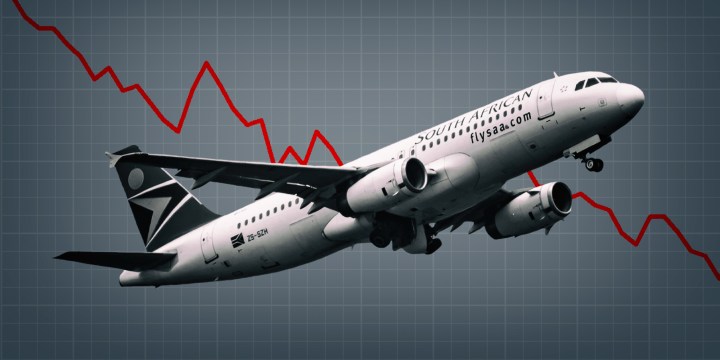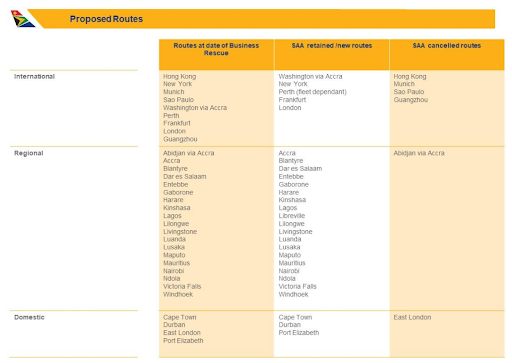BUSINESS MAVERICK
New SAA requires R26.7bn from taxpayers to be airborne

SAA, which last turned a profit in 2011, is still expected to have a negative cash flow position over the next five years. The airline is expected to have a cumulative negative cash-flow position of R59.7bn between the financial years 2021 and 2025.
The business rescue practitioners of SAA have ditched a plan to launch a new state-owned airline, but have proposed keeping the old SAA and restructuring it to have smaller aviation operations.
A restructured SAA or SAA 2.0 will still be state-owned, have a reduced workforce of 1,000 after retrenching 3,700 workers, and is expected to operate a full flight schedule of domestic routes – Cape Town, Durban, and Port Elizabeth – from January 2021. International and regional routes, which have been cut to five and 19 respectively, will resume once the demand for air travel by customers grows post the Covid-19 period.

Source: SAA business rescue plan.
By January 2021, SAA will reduce the number of its aircraft fleet to 26 from 44 after returning small, narrow and wide-body planes to aircraft lessors.
SAA, which last turned a profit in 2011, is still expected to have a negative cash-flow position over the next five years. The airline is expected to have a cumulative negative cash-flow position of R59.7-billion between the financial years 2021 and 2025.
SAA was placed under business rescue on 6 December 2019 because it did not have working capital to fund operations.
Details of a restructured SAA are contained in a final business rescue plan, which was published on Tuesday 16 June by rescue practitioners Siviwe Dongwana and Les Matuson, and circulated to the airline’s affected parties.
A restructured SAA will still depend on public finances or the taxpayer, as a total of R26.7-billion – of which R10.3-billion is new money – will be required to settle the airline’s debt, fund the restart of its operations, and pay retrenchment packages to about 3,700 workers and creditors, whose debt is not guaranteed by the government, including aircraft lessors.
Of the R26.7-billion, R16.4-billion had already been allocated in the February 2020 Budget by Finance Minister Tito Mboweni for SAA to repay its historical debt to commercial banks, which are the airline’s biggest creditors and whose loans are guaranteed by the government.
No funding for SAA from the government
The plan is sketchy on whether the National Treasury has committed to funding the restructuring of SAA at a time when public finances are severely constrained by the Covid-19 crisis, with most economists expecting the Budget deficit to widen to 10% of GDP in 2020/21 compared with a forecast 6.8% in the February Budget.
Dongwana and Matuson are convinced that the government will throw SAA another lifeline over and above the R22-billion in government bailouts that the airline has received since 2009.
“[The] government, as the sole shareholder of the company [SAA] and acting through DPE [Department of Public Enterprises], supports a business rescue which results in a viable and sustainable national flag carrier that provides international, regional and domestic services,” the rescue practitioners said in the 110-page business rescue plan.
But the government and rescue practitioners have agreed that a restructured airline “will not be dependent on further future bailouts from the fiscus”.
SAA affected parties are expected to vote for the business rescue plan on 25 June. Creditors will be asked to adopt the plan before Dongwana and Matuson get a firm commitment from the government on whether it will support SAA’s further funding requirements. Dongwana and Matuson have given the Department of Public Enterprises and National Treasury a deadline of 15 July to commit to more funding for SAA.
To implement the restructuring proposals, the business rescue plan requires support/approval from about 75% of SAA creditors, according to the Companies Act, which regulates business rescue proceedings in SA. The plan will probably be approved because a majority of SAA creditors are commercial banks – including Nedbank (owed R3.3-billion), Absa (R2.9-billion), Standard Bank (R1.6-billion), and Investec (R1.6-billion) – that outweigh smaller creditors and stand to receive money that they are owed in full.
Aircraft lessors will receive R1.7-billion – equivalent to six months’ rental – to be paid over the next three years. Meanwhile, smaller creditors will receive R600-million or 7.5 cents in the rand over the next three years.
The Department of Public Enterprises said it supports the business rescue plan “where it results in a viable, sustainable airline that provides integrated domestic, regional flight services”.
“Through government guarantees, the BRPs [business rescue practitioners] have had significant additional financial resources at their disposal to enable them to restructure SAA by stemming the tide of wastage, an excessive cost-structure and cash burn. We will assess the plan which, we are concerned, might have not been adequately accomplished,” the department said in a statement.
Abandoned plan for a new airline
Dongwana and Matuson have abandoned an earlier stated plan of launching a new airline that will purchase the entire shareholding of the old SAA and introduce strategic equity partners. This plan was strongly supported by Public Enterprises Minister Pravin Gordhan.
Dongwana and Matuson have instead suggested keeping the current SAA shareholding structure – with the government being the sole shareholder – and all its subsidiaries: Mango (low-cost carrier), SAA Technical (aircraft maintenance), Air Chefs (catering), and SAA Cargo (air freight movement). But the subsidiaries require capital to restart operations, including Mango (R1-billion), SAA Technical (R1-billion), and Air Chefs (R150-million).
The plan is thin on details of how the airline will be run in a post-Covid-19 world, where airlines will struggle to generate profits as passenger volumes are expected to still be lower. DM/BM



















 Become an Insider
Become an Insider